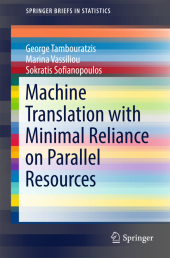 Neuerscheinungen 2017Stand: 2020-02-01 |
Schnellsuche
ISBN/Stichwort/Autor
|
Herderstraße 10
10625 Berlin
Tel.: 030 315 714 16
Fax 030 315 714 14
info@buchspektrum.de |

Sokratis Sofianopoulos, George Tambouratzis, Marina Vassiliou
(Beteiligte)
Machine Translation with Minimal Reliance on Parallel Resources
1st ed. 2017. 2017. ix, 88 S. 17 SW-Abb., 30 Farbtabellen. 235 mm
Verlag/Jahr: SPRINGER, BERLIN; SPRINGER INTERNATIONAL PUBLISHING 2017
ISBN: 3-319-63105-5 (3319631055)
Neue ISBN: 978-3-319-63105-9 (9783319631059)
Preis und Lieferzeit: Bitte klicken
This book provides a unified view on a new methodology for Machine Translation (MT). This methodology extracts information from widely available resources (extensive monolingual corpora) while only assuming the existence of a very limited parallel corpus, thus having a unique starting point to Statistical Machine Translation (SMT). In this book, a detailed presentation of the methodology principles and system architecture is followed by a series of experiments, where the proposed system is compared to other MT systems using a set of established metrics including BLEU, NIST, Meteor and TER. Additionally, a free-to-use code is available, that allows the creation of new MT systems. The volume is addressed to both language professionals and researchers. Prerequisites for the readers are very limited and include a basic understanding of the machine translation as well as of the basic tools of natural language processing.
Chapter 1: Preliminaries 1
1.1 Challenges in MT - Relevance to the European environment 1
1.2 A brief review of MT development history. 2
1.3 Advantages and disadvantages of main MT paradigms 3
1.4 The PRESEMT methodology in a nutshell 7
1.5 Closing note on implementation. 9
1.6 References 9
1.7 Glossary of Terms 12
Chapter 2: Implementation. 14
2.1 Introduction: Summary of the approach. 14
2.2 Linguistic resources: Data and existing linguistic tools 15
2.2.1 External processing tools 16
2.2.2 Lemma-based bilingual dictionary . 17
2.2.3 The parallel corpus 19
2.2.4 The TL monolingual corpus 22
2.3 Processing the parallel corpus 22
2.3.1 Phrase Aligner Module . 23
2.3.2 Phrasing Model Generation . 28
2.4 Creating a language model for the target language. 30
2.5 References 32
Chapter 3: Main translation process 34
3.1 Introduction. 34
3.2 Translation Phase one: Structure Selection. 35
3.2.1 The Dynamic Programming algorithm .. 37
3.2.2 Example of how Structure Selection works 39
3.3 Phase two: Translation Equivalent Selection. 40
3.3.1 Applying the language model to the task . 42
3.3.2 Example of how TES works 44
3.4 References 45
Chapter 4: Assessing PRESEMT. 47
4.1 Evaluation dataset 47
4.2 Objective evaluation metrics 48
4.3 System evaluation. 49
4.3.1 Evaluation objectives 49
4.3.2 Evaluation results 50
4.3.3 Expanding the comparison . 51
4.3.4 Experimenting with further data . 52
4.4 Comparing PRESEMT to other MT systems 53
4.5 Conclusions 56
4.6 References 57
Chapter 5: Expanding the system.. 58
5.1 Preparing the system for new language pairs 58
5.2 Examining language-pair-specific issues 60
5.2.1 Agreement within a nominal phrase . 60
5.2.2 Case mismatches 61
5.2.3 The null subject parameter 61
5.2.4 Word order 62
5.3 Notes on implementation. 62
5.4 Conclusions 63
5.5 References 63
Chapter 6: Extensions to the PRESEMT methodology. 64
6.1 Splitting SL sentences into phrases more accurately. 64
6.1.1 Design and implementation of TEM .. 65
6.1.2 Experimental evaluation . 68
6.1.3 Conclusions 70
6.2 Combining language models of different granularity. 71
6.2.1 Extracting the n-gram models 72
6.2.2 Experimental results 74
6.2.3 Discussion . 75
6.3 References 76
Chapter 7: Conclusions and future work. 78
7.1 Review of the effectiveness of the PRESEMT methodology. 78
7.2 Likely avenues for improvements in translation quality. 79
7.2.1 Automatic enrichment of dictionary . 79
7.2.2 Design and implementation of TEM .. 80
7.2.3 Grouping of tokens and PoS tags into related classes 81
7.2.4 Revision of the Structure Selection translation phase . 81
7.2.5 Improving the alignment of words/phrases 82
7.2.6 Augmenting the TL language model to cover supra-phrasal segments 83
7.2.7 A closing evaluation of translation accuracy . 84
7.3 References 85


